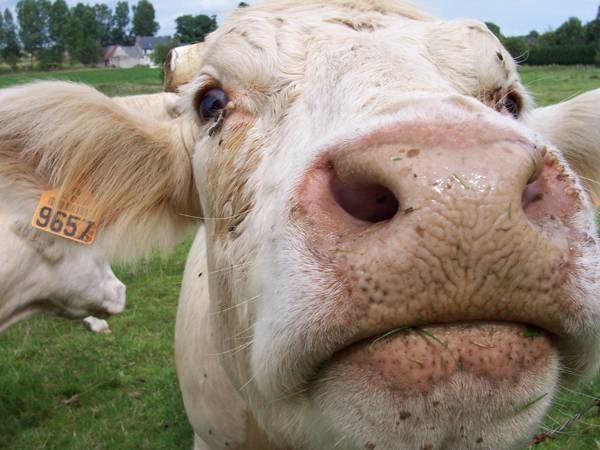FREDERICK: EPA proposal could cost millions

Photo Courtesy: Treehugger.com
December 11, 2008
When it comes to the crusade against global warming and greenhouse gases, nothing, it seems, is sacred. Not even cow farts.
Under a U.S. Supreme Court ruling in April 2007, greenhouse gases are now considered pollutants under the provisions of the Clean Air Act. As such, the Environmental Protection Agency is empowered to regulate them. This regulatory power could have some rather unfortunate and unintended consequences, however.
Under the EPA’s recommendation, agricultural greenhouse gas emissions would be regulated under existing Clean Air Act regulations governing hazardous air pollutants. While these standards, which were never intended or designed to govern this sort of pollutant, could impact agricultural operations in this country in more ways than could possibly be addressed here, the cost of permitting these operations [?] is a major and troubling concern.
Emissions permits are required for facilities emitting more than 100 tons of pollutants annually. That’s a 25-cow dairy, a 50-head beef cattle operation, a 200-head hog operation or 500 acres of corn. That affects almost every operation in the nation to some extent.
The costs involved in obtaining permits aren’t inconsequential, either. The EPA’s minimum annual permitting fee schedule would look something like this: $175 per dairy cow, $87.50 per head for beef cattle and $20 per head for hogs.
Those may not seem like huge numbers, until you start to expand them to the entire industry. The Iowa Farm Bureau Federation estimates that, statewide, the cost of permitting livestock and corn operations under the EPA’s proposal could run anywhere from just over $697 million to nearly $1.4 billion.
Take a modest hog operation, for instance, which IFBF uses as an example: 5,000 head of hogs and 500 acres of corn. Not a massive operation, by any means. The operators of this sample hog farm would pay in the area of $154,000 in permitting fees annually.
If that’s not staggering, it should be. Iowa State University Extension reported an average yield per acre of corn in the Ames area in the 200 bushel-per-acre range for 2006. With prices on the Chicago Board of Trade at current levels, more than 22 acres from the above example goes just to pay for the emissions permits.
Regardless of the details in the calculations, a basic economic fact is uncovered here: These proposed regulations would have a profoundly negative impact on the balance sheets of agriculturists across the country. These costs would eventually have to be made up for in the form of higher prices. The alternative is to lose many of our farmers, which would eventually lead to higher prices anyway.
This, then, isn’t just a farm issue — it’s a kitchen table issue.
One version of an old proverb says something to this effect: “Society is only three missed meals from a revolution, and four missed meals from anarchy.”
The viability of the American farmer isn’t something to be trifled with. It’s a national security issue, it’s a global hunger issue, it’s a world peace issue, an economic issue, a quality of life issue, a rural, urban and suburban issue. It affects every facet of life as we know it, from pizza to beer, lipstick, glue and fuel.
While certain cases may possibly be presented for restricting access to other vital resources — such as the almost temper-tantrum passion against drilling for oil that we already know we have — no such argument can be presented for handicapping our agricultural resources in this manner.
Food is the engine that drives nations. The ancient Romans knew that, the ancient Egyptians knew that, and we can’t afford to forget it, even if our kitchen tables are more removed than ever from the feedlot.
Here in the heart of the Corn Belt, in the midst of the finest farmland on the face of planet Earth, are the pistons and spark plugs of that engine. Fifty percent of the nation’s corn comes out of the Corn Belt. Last year nearly 30 percent of the nation’s hogs, five-and-a-half percent of the nation’s cattle and one out of every five kernels of corn came from right here in Iowa. It’s what we’re good at here. It’s what the land is good for here. The depth and breadth of these proposed regulations threatens to destroy all that generations of Iowans and Americans have built — farms and operations, both large and small — all in the name of regulating emissions.
It must be asked: Are we, at long last, to become subjects of a communism of carbon? Will we allow fear to dictate to us an irrational course of action, potentially leaving many around the globe unfed?
We’re smarter than that. We know we’re smarter than that. For one thing, permits or not, the cows will still fart. It’s quite possible for the EPA to shut down a factory that doesn’t have its emissions permit. It’s a touch more difficult — or perhaps only a touch more permanent — to shut down, say, a cow that farts despite not having a permit.
There are other, albeit much more sane and well-reasoned, ways to go about these things, rather than attempting to address a problem as large and pressing as greenhouse gas emissions under legislation that was never designed to deal with it.
Government agencies, however, are seldom sane and almost never well-reasoned. Fortunately, the Midwest — which has perhaps the biggest vested interest in seeing this bizarre proposal go away — tends to keep some pretty influential company on Capitol Hill. For our part here in Iowa, Sens. Tom Harkin and Charles Grassley and our cadre of congressmen make themselves very available to their constituents.
Let’s go save the world — from more than cow farts.
— Ryan Frederick is a senior in management from Orient
















